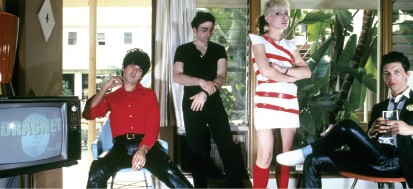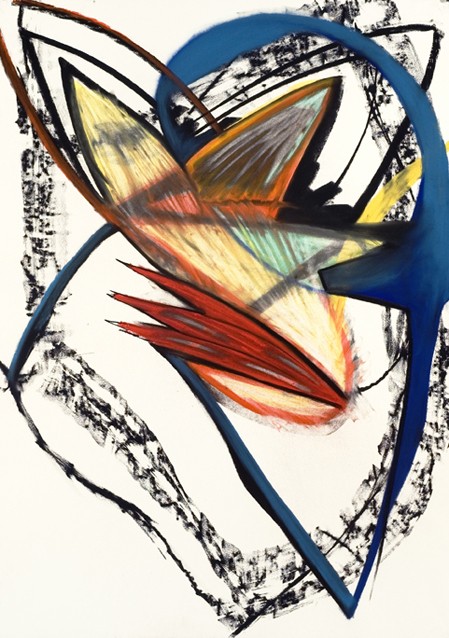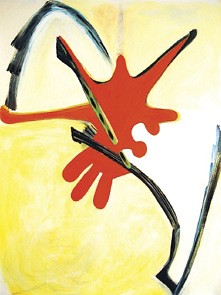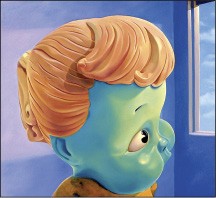This week’s Flyer editorial offers some perspective on the long tenure of Mayor Herenton.
Month: July 2009
Ostrander Nominees
 On Sunday, August 30 the Memphis Theater Community will celebrate the best of the 2008-’09 season and raise a toast to actor/director, and recently retired University of Memphis theater professor Joanna “Josie” Helming when she receives the Eugart Yerian Award for Lifetime Achievement at the 26th annual Ostrander Awards. Helming was recruited to do her graduate studies in Memphis by Keith Kennedy, who founded the U of M’s Department of Theatre & Dance. She finished her MA in 1967 and became cornerstone of the U of M’s performance faculty.
On Sunday, August 30 the Memphis Theater Community will celebrate the best of the 2008-’09 season and raise a toast to actor/director, and recently retired University of Memphis theater professor Joanna “Josie” Helming when she receives the Eugart Yerian Award for Lifetime Achievement at the 26th annual Ostrander Awards. Helming was recruited to do her graduate studies in Memphis by Keith Kennedy, who founded the U of M’s Department of Theatre & Dance. She finished her MA in 1967 and became cornerstone of the U of M’s performance faculty.
Now, without much ado, here are the nominees for this year’s Ostrander awards…
Pictured: Josie Helming in Candida
Arrow Rock Lyceum, 1973
Mayor Herenton’s Last Day
On his last official day in office, Mayor Willie Herenton has scheduled a 2:00 p.m. press conference. Jackson Baker and other Flyer writers will be on hand. Watch this space for developments.
Meanwhile, you can scroll down and check out the Flyer blogs.
 The New York Times has a story up on Cybill Shepherd, a hometowner who’s earned favored-celebrity status from Memphians after four decades in the public eye.
The New York Times has a story up on Cybill Shepherd, a hometowner who’s earned favored-celebrity status from Memphians after four decades in the public eye.
Margy Rochlin’s story starts, “The first time Cybill Shepherd appeared on a talk show was on The Tonight Show back in 1968. At the time she was a radiant 18-year-old from Memphis with a confrontational gaze who owned the title Model of the Year. ‘I could barely say a word,’ she said. ‘All I could do was say ‘Yes’ and look terrified.’”
Look for more Cybill in the future; as soon as this weekend, in fact, with Mrs. Washington Goes to Smith, which airs on the Hallmark Channel Saturday at 8 p.m.
She’ll also have a recurring role on Eastwick, an ABC show based on The Witches of Eastwick — you remember that, right? — that drops in September.
Midtown Water Woes
When city officials sought to reassure Midtowners that they wouldn’t notice a proposed 18-foot storm-water detention basin in Overton Park, they cited a similar project at Christian Brothers University.
But that detention basin has already caught the eye — and nose — of local residents. Mary Cashiola reports.
Unless yet another “Herenton shock” has occurred between the writing
of these words on Tuesday and the mayor’s scheduled leave-taking from
his duties on Thursday, the city of Memphis is finally about to enter
onto new and uncharted paths. It has long been presumed by the political
cognoscenti that Shelby County mayor A C Wharton — conciliatory
where Herenton is challenging; smooth where the outgoing Memphis mayor
has been peremptory — will accede to the job of city mayor. But
we have been through multiple surprises of late, and we’re not about to
take anything for granted.
The special mayoral election, certified by the City Council and
scheduled by the Election Commission, will take place on October 27th.
We’ll know who wins it when they’re finished counting the votes —
and not until — although there is reason to believe that Wharton
may have ranked prohibitively high in the poll that city councilman and
erstwhile mayoral prospect Jim Strickland recently commissioned, only
to decide against running upon receipt of it.
In summing up the 18 years of Mayor Herenton, it would be unfair to
judge the man only, or even mainly, by the conflict-of-interest
questions that have swirled up around him in recent years, or by the
increasing cronyism of his administration, or by his manifest boredom
with his job, or even by his ominous evocations of the race issue as he
revs up for an apparent run against 9th District congressman Steve
Cohen. The word “racist” as an epithet to describe his critics surfaced
only last week, when the mayor chose to be offended by public
questioning of his on-again, off-again timetable for leaving, so we
fear we shall hear it again as a counter to all sorts of future
questions.
Yet this is also the man who provided a reasonably seamless
transition in 1991 between all the years of white-dominated, even
segregated, city government that preceded him and the generation of
slow but real racial accommodation that has followed. Yes, there has
been “white flight” (and middle-class black flight, as well), but
personal and professional relationships across the old racial barrier
have multiplied since 1991, and Herenton is entitled to some credit for
that — as he certainly is for his vaunted conversion of
dilapidated public housing into some of the showcase projects that now
dot the city’s landscape.
In other words, things could have been a lot worse. We at the
Flyer named Mayor Herenton “Man of the Year” for 1997 for his
resourceful, even heroic defense of the city’s growth prerogatives
against the encroachments of the infamous “toy town” act that would
have balkanized Shelby County and hemmed in Memphis. Without Herenton’s
pressing the issue, the act might never have been tested by the state
Supreme Court and declared unconstitutional.
In any case, we wish ex-Mayor Herenton (though not necessarily
candidate Herenton) well as he enters the next phase of his life and
career. He has been a titanic influence in our affairs, and his
reputation can only grow if he comports himself with dignity — or
sadly sink if he does not.
Two Testaments
Hip-hop has produced more momentous artists than De La Soul. Run-DMC, Public Enemy, Eric B. & Rakim, Notorious B.I.G., Outkast, and a few others have a greater claim to the genre’s Mt. Rushmore. But in a culture so far short on longevity and mutability, I know of no other hip-hop artists whose peaks are more than a decade apart and who have had as much to say to the music’s fans — once referred to as the hip-hop generation — about living a rewarding life.
As Long Island teenagers making their debut with the precocious epic
3 Feet High and Rising, this trio — Kelvin “Posdnuos”
Mercer, Dave “Trugoy the Dove” Jolicoeur, and Vincent “Mase” Mason
— bravely tested hip-hop’s cultural boundaries, burrowing deeply
into their own idiosyncratic personalities. Later, as thirtysomething
fathers on the deep and subtle AOI: Bionix, they crafted the
most convincing argument yet for what hip-hop as stable grown folks’
music might sound like.
“Sony Walkmans keep us moving/De La Soul can help us
breathe.”
— “Tread Water,” 3 Feet High and
Rising
Released in 1989, 3 Feet High and Rising spearheaded a
hip-hop movement known as the Native Tongues, a loose affiliation (or,
in Tongues parlance, a tribe) of artists such as A Tribe Called Quest,
Jungle Brothers, and Queen Latifah united by a philosophy of
“Afrohumanism” and a playful sense of sonic exploration. The Native
Tongues offered both a middle-class alternative to a form born in the
New York City streets and housing projects and a gentler alternative
within a genre then divided by the political militance of Public Enemy
on the East Coast and the gangsta aesthetic of N.W.A. on the West
Coast.
De La’s debut was a commercial hit and a relative critical smash,
winning 1989’s Village Voice “Pazz and Jop” national critics
poll, becoming the first teen winner and first debut-album winner since
the Sex Pistols. But even then some found it too slight to be a Great
Album, its full-fledged songs interrupted by recurring skits (a
practice it launched, for better or worse), esoteric jokes, and other
aural experiments, and its perspective too unreadable and
navel-gazing.
Fans dubbed it “the hip-hop Sgt. Pepper’s,” but in retrospect
“the hip-hop White Album” is probably a more apt Beatles
comparison. More audacious and more definitive than anything else to
come out of the Native Tongues crew, it’s a sprawling 24-track
invitation to an unknown world, filled with in-group solidarity (“The
Magic Number,” “Me, Myself, and I”), social commentary (“Ghetto Thang,”
“Say No Go”), inspired DJ cut-and-paste (“Cool Breeze on the Rocks”),
Aesop-like fables (“Tread Water”), and total weirdness (“Transmitting
Live From Mars,” 66 seconds of a scratchy French spoken-word record
over a Turtles sample).
It’s an album that contains both hip-hop’s first convincing love
song with “Eye Know” (right, LL Cool J’s “I Need Love” came first, but
he just wanted to get in your pants) and still the genre’s healthiest
sex song with the posse cut “Buddy.” And despite its teen-oriented
self-absorption, it has a fierce spirit. The first rapped verse on the
record, courtesy of 19-year-old Posdnuos: “Difficult preaching is
Posdnuos’ pleasure/Pleasure and preaching starts in the heart.”
With its “D.A.I.S.Y. Age” rhetoric (which stands for “Da Inner
Sound, Y’all” — don’t laugh), Day-Glo color schemes, private
lingo, unexpected references (stray lyrics about Fred Astaire and
Waiting for Godot), and inscrutable in-jokes (“Posdnuos has a
lot of dandruff”), 3 Feet High and Rising was the sound of
creative teenagers energized by their own brains. As much as indie-rock
kings-in-waiting Pavement, who emerged soon after, these were modestly
privileged suburban bohemians turning their surfeit of leisure time and
their overactive intellects into something familiar yet totally new,
its verbal imagination actually topped by its sonic imagination.
Two years earlier, fellow Long Islander Rakim — as
culturally conservative as De La Soul were radical — had made a
claim for the genre: “Even if it’s jazz or the quiet storm/I hook a
beat up/Convert it into hip-hop form.” It’s a classic lyric, one that
announced the genre’s voracious musical appetite. But Rakim couldn’t
think past mainstream African-American forms. De La, inspired by George
Clinton’s Parliament-Funkadelic and partnered with sampling genius
Prince Paul, took Rakim’s manifesto and added to the list Hall &
Oates, Steely Dan, Johnny Cash, Schoolhouse Rock, and a
French-language instructional record, just for starters.
Underground mix-masters like Double Dee & Steinksi were earlier
to the game, and the Beastie Boys would double-down on De La’s
achievement later the same year with Paul’s Boutique, but more
than anything else, 3 Feet High and Rising expanded hip-hop’s
sonic vocabulary.
As insistent as the trio had been initially to confront hip-hop’s
cultural boundaries (perhaps captured best in the comically put-upon
“Me, Myself, and I” video), they did succumb to peer pressure,
recording the fed-up defense to a stupid recurring description, “Ain’t
Hip To Be Labeled a Hippie,” and then following up 3 Feet with
the self-conscious and self-negating De La Soul Is Dead.
But 3 Feet‘s influence won out. The sonic message was that
absolutely anything could be turned into hip-hop. But the personal
message was that hip-hop could be anyone’s vehicle for self-expression,
a message later embraced by white trailer-park residents (Eminem),
mixed-race Midwesterners (Atmosphere), nice middle-class white girls
(Northern State), Third World survivors (M.I.A., K’ Naan), and lots of
other people with something to say and a beat to say it over.
“No need to spit a cipher to show you I’m a lifer in rap/I
cultivate moves larger than that.”
— “Bionix,” AOI: Bionix
3 Feet High and Rising‘s sonic fragmentation is generational
but also partly a production of youth. Feeling creakier on the wrong
side of 30, the band pursued a steadier groove on their Art Official
Intelligence (AOI) records: 2000’s Mosaic Thump and
2001’s better Bionix (the latter getting my vote as the past
decade’s most overlooked hip-hop album). Where 3 Feet was bumpy,
the AOI records are smooth. Where 3 Feet was clever and
cryptic, the AOI records are smarter and more plainspoken.
What the trio lost in youthful verve they made up for with a
consistently rewarding musical vision on their second career peak.
Rather than the Prince Paul-organized bricolage and jokiness of 3
Feet High and Rising, here is hip-hop as the ultimate adult
R&B, without the confrontational assault or showy party vibe of
most contemporary mainstream hip-hop or the spare beats of the
underground. Rather, De La’s AOI records luxuriate in the
sturdy, comfortable, and soulful — groove music for
stay-at-homes. This music doesn’t grab you, but it deepens over
time.
And it’s no accident that the more limited sources but more
consistent groove connects more fully to the African-American musical
tradition. After flying their freak-flag as kids, this later music
embodied the black middle-class experience they were living. Even the
skits on Bionix (“Rev. Do Good”) tap into an African-American
iconography that might have felt limiting as teenagers.
With AOI: Bionix, the group united verbal concept with the
music’s grasp for the eternal. This was an album about growing up
without giving out. Its most compelling moment comes on the concluding
“Trying People,” one of the first pop-music acknowledgements of 9/11
outside of tribute-song rush jobs. The song is directed at hip-hop’s
younger generation, with Dave (long since dropping his old “Trugoy”
moniker) rapping, “You see, young minds are now made of armor/I’m
trying to pop a hole in your Yankee cap/Absorb me/The skies over your
head ain’t safe no more/And hip-hop ain’t your home.”
Once obsessed with making music in their bedrooms, the group was now
focused on a different set of priorities: “Got fans around the
world/But my girl’s not one of them,” Posdnous raps on the same song.
“And my relationship’s a big question/’Cause my career’s a clear
hindrance to her progression/Says she needs a man and her kids need a
father/And I’m not at all ready to hear her say ‘don’t bother.'”
This central conceit is explored all over the record. The opening
scene-setter, “Bionix,” features lyrics such as, “I don’t ball too
much, ya dig/I got a ball and chain at the crib who want my ass at
home.” The charming lead single, “Baby Phat,” is the middle-aged answer
to Sir Mix-a-Lot’s “Baby Got Back”: “Your shape’s not what I dig/It’s
you … You ain’t in this alone/I got a tummy too/Just let me watch
your weight/Don’t let it trouble you.” On “Simply,” they search for a
place to have fun without young “thugs” ruining everything, and on
“Watch Out,” they make romance by proposing a joint account.
The record’s decorum breaks down toward the end with the sexed-up
“Pawn Star” (which should surprise no one who remembers 3 Feet High
and Rising‘s “De La Orgie”) and the funny, conflicted marijuana
meditation “Peer Pressure” (with Cypress Hill’s B-Real). But this
detour is needed confirmation that adulthood doesn’t have to equal
stodgy.
Hip-hop hasn’t yet proven to be a form with the personal longevity
of blues, country, or even rock. But after saying more about both
teendom and responsible adulthood than anyone in the so-called hip-hop
nation, one hopes De La Soul can stay interested long enough to pull
hip-hop into the uncharted territory of middle age.
No Exit

As the name of Blondie’s 1999 comeback album No Exit implies, there seems to be no end for
these new-wave legends.
Debbie Harry & Co. (pictured) hit the road this summer with
rocker Pat Benatar and late-’90s hard-rock girl band the Donnas. The
tour stops in Memphis for a show at Mud Island on Saturday, August 1st.
Blondie drummer Clem Burke took a few minutes from the road to speak to
the Flyer about Blondie’s past and future.
Flyer: Rap music is a huge force in Memphis. But
didn’t Blondie pioneer rap with “Rapture” in 1981?
Clem Burke: I’m sure it was the first hit rap song. The
melody to the song was written by the band, while a lot of rap music at
the time sampled other hit songs. But we wrote our own hit song and put
the rap in, and that’s kind of the template today for modern-day rap,
like with Kanye West.
What’s your favorite Blondie song?
It’s difficult to
choose. But my favorite record is Autoamerican, which has
“Rapture” on it. When we delivered that record to the record company,
they told us it didn’t have any hits, and it ended up having two
number-ones, “The Tide Is High” and “Rapture.”
Is there a new Blondie album in the works?
We hope to have a new record out by the middle of next year. One of
the reasons we went on tour now is to get the band up and running.
We’ll go into the studio afterward and record some new work. We’ve
recorded a few new songs. We’ll be playing one or two when the mood
strikes us during the show.
Amazing Race

The Memphis Riverfront International Championship Regatta: That’s
quite a mouthful. But the title befits the event, which boasts an
extensive list of attractions and hopes to draw a sizable crowd to Tom
Lee Park July 31st through August 2nd. The regatta is not only the
first in Memphis, it is the first on the Mighty Mississippi — a
stretch of river that boat racers have been clamoring to tackle for
years.
Jesse Briggs, event coordinator, says this race will make Memphis a
major player in the powerboat arena. Whereas high-speed boat races
usually bring in around 20 boats, Briggs expects to have 40 boats
contending for the championship. Powerboat contestants will race around
a rectangular track, reaching speeds of up to 125 mph. Between races,
the waterway is cleared to accommodate passing barges, something Briggs
touts as a sort of slow-paced interlude. In addition to high-speed boat
races, the regatta will feature live music, food vendors, kiddie park,
kayak races, and jet-ski acrobatics. Radio station Rock 103 is covering
the event, along with Fox Sports South.
This is the inaugural race of what is slated to be a yearly event.
“We have a five-year contract with the APR Powerboat Super League to
make their championship cup destination the great city of Memphis, with
an option for an additional five years,” Briggs explains.
The festivities begin each day at 10 a.m. and end at 7 p.m. After
the races on Saturday, head over to Primetime Sports Bar and Grill for
an after-party with the drivers, V.I.P.s, and sponsors. And as for
tickets? “The event is free,” Briggs says. “It’s what we like to call
financially friendly.”
Points of View
The current exhibition at the Dixon’s Mallory and Wurtzburger
Galleries, titled simply “Beth Edwards,” is the most complete gathering
to date of Edwards’ emotionally complex portraits of the
mid-20th-century American dream of owning shiny new convertibles and
ranch-style homes furnished with Danish modern divans, potted plants,
and modern artworks, or, if original work was out of the question, good
reproductions.
Instead of human models, Edwards uses vintage rubber toys as
stand-ins for the proud homeowners. In Happy Day, an
anthropomorphic mouse with a frozen smile and huge lidless eyes stands
proudly in his spic and span living room. The shape of his moist black
nose is repeated in the fractured face of Picasso’s portrait of his
mistress Marie-Thérèse Walter. In Good Morning,
another happy homeowner — in this case, a beautiful, young golden
retriever — is backdropped by a royal-blue divan and Philip
Guston’s painting of a huge pile of worn-out footwear (horses and
humans), an allusion perhaps to the labor required to build beautiful
homes for the well-heeled.

Pinkney Herbert’s Delta Series L
The glossy surfaces, controversial masterworks (that elicited
outrage when they were first unveiled), and the frozen-faced dolls that
populate Edwards’ “happy paintings” suggest the search for happiness is
a slippery slope layered with complex feelings that can exhilarate or
undo us.
Like Edward Hopper, Edwards handles color with such mastery that her
artwork achieves a kind of transcendence. The iridescent-green baby
doll in Annunciation looks out a window at a blue sky feathered
with clouds. The figure’s chubby cheeks and huge brow are framed inside
a Hopperesque square of lavender light.
Ultimately, Edwards’ art is about the power of light to consume all
color and form, to absorb all paradox and pain into visions of
paradise. Edwards understands Hopper’s desire to do nothing but paint
light on the side of a house.
Through September 6th

Pinkney Herbert’s Jig
In David Lusk Gallery’s current show, “Floating World,” Pinkney
Herbert’s paintings no longer blast our point of view across
30-square-foot surfaces. Neither are they as spare as the paintings in
Herbert’s 2007 exhibition, a show in which softly curving lines,
wide-open spaces, and the quiet authority of works like Wing
seem inspired as much by Zen Buddhism as 20th-century
abstraction.
Instead, Herbert’s “Floating World” works are by turns fluid,
syncopated, celebratory. Their open and buoyant compositions, inspired
in part by the elegant woodblock prints of Japan’s Edo period
(1603-1868), invite us to take our time, to explore their textures,
colors, and shapes, and to realize that, though they are more subdued
than Herbert’s explosive earlier work, these paintings are as evocative
and original as any in his long and varied career.

Beth Edwards’ Annunciation
In “Floating World,” we feel the rhythms of New York as well as
Memphis, the two cities where Herbert lives and paints. Deep-red spiked
flowers surrounded by scumbled umber at the heart of Herbert’s pastel
on paper Delta Series L look as rich as Mississippi bottomlands,
as fertile as the Southern soul. In Buoy, a figure eight
accented with red-and-yellow lozenges wafts on air currents that twist
in unexpected directions like New York City’s improvisational jazz.
A cartoon-like hand with triple-jointed fingers and attenuated wrist
lies at the center of the nearly 6-foot-tall painting Jig. We
can almost hear the sound of one hand clapping in this crisp-edged,
bright-orange shape backdropped by a wash of pure yellow.
Two years after his last show, Herbert returns to David Lusk with
his sense of humor intact, with a new zest for life, with a mindset
similar to what 17th-century Japanese novelist Asi Ryoi described in
Tales of the Floating World as “refusing to be disheartened,”
turning one’s attention to the pleasures of the beautiful, impermanent
world.